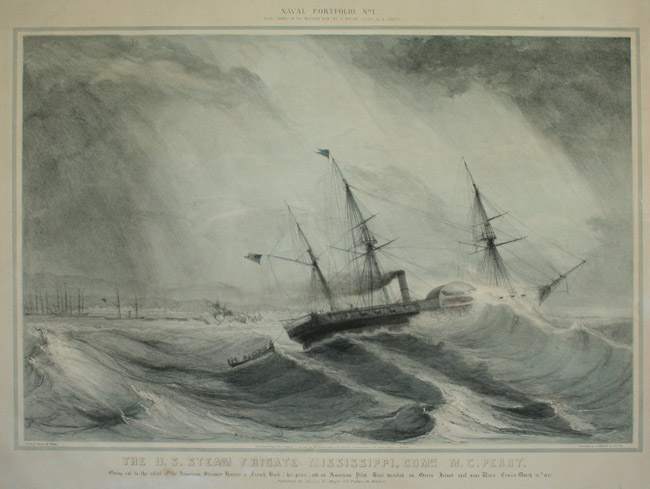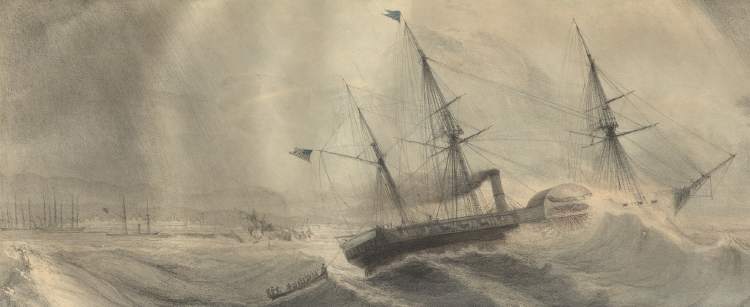|
Naval Portfolio, No 1.
Henry Walke

Available for Purchase, click here. Price on request.
Henry Walke's Classic Naval Lithograph Portfolio.
Perhaps the rarest American Naval print series was created by then Lieutenant H. (Henry) Walke. It is a series of eight lithographs depicting Naval actions in the Mexican War in the Spring and Summer of 1847. Walke served in the war as the second in command of the U.S.S. Vesuvius, a bomb brig of the Gulf Squadron. During the war the Vesuvius participated in the blockade of Laguna and supported landings at Tuxpan and Tabasco.
After serving for eight months on the Vesuvius, Walke returned to the United States in October 1847 and went on extended leave until September of 1848. On his return he immediately began work on his Naval lithograph portfolio and it was completed during this period.
All of the lithographs were after original art by Walke. He personally rendered five of them onto the lithograph stones. Numbers 1, 3, 4, 5 & 7 were executed by Walke onto the lithograph stones. The others (Nos. 2, 6 & 8) were executed on the lithograph stones by others but based upon Walke's original art.
"Naval Portfolio .... No. 1~8" is stated at the top of each lithograph. There is also a line of text in smaller print reading "Naval Scenes in the Mexican War by H. Walke, Lieut. U.S. Navy." The image is surrounded by a thick (2~4 mm wide) frame box. Directly below the image and within the frame box, small print text is seen at the left (lithographer - "Sarony & Major"), middle ("Entered according to Act of Congress in the year 1847 (1848)...."). Those lithographs actually executed by Walke on the lithograph stone (Nos 1, 3, 4, 5 & 7) state "Executed by H. Walke, Lt, U.S.N." or "Designed and Drawn on Stone by H. Walke, Lt, U.S.N." at the far right. When the H. Walke work was actually rendered onto the lithograph stone by another artist (Nos. 2, 6 & 8) at the far left it states "Painted by H.Walke L. U.S.N, Drawn on Stone by (name of artist)." At the bottom under the image frame box in large print is the title of the image in double line letters. This is followed by lines of smaller print with descriptive text which contains a date of for the naval action depicted. On some of the lithographs the name and address of the lithographer/publisher ("Published by Sarony & Major, 117 Fulton Street, New York.") is stated below the descriptive text. The name of the publisher/lithographer (Sarony & Major) is often found at the far right or far left under the image but within the image box.
The plate size of these lithographs is generally 20 3/4 x 26 3/4+ in (53 x 68 cm). The Yale University Library lists the size of the prints as 54 x 73 cm. The image areas (including the image frame box) vary slightly but generally measure 15~15 1/4 x 21 1/4~22 1/2 in (37.8~38.5 x 53.8~56.8 cm).
The most of the lithographs I would call tinted lithographs. There are executed in black & white and contain an additional tint color tint. Some of the lithographs contain more that one tint and appear to be properly classified as multi-color (chromolithographs).
This work is sometimes described as a book. It apparently was issued with a folio case to house the loose lithographs. Complete sets of all eight lithographs are rarely seen. Even single lithographs are seldom seen and generally in poor condition. The Library of Congress on-line exhibit titled "Pictorial America" contains all 8 of these lithographs.
Naval Portfolio No. 1
Title: "The U.S. Steam Frigate Mississippi, Comre. M.C. Perry. Going out to the relief of the American Steamer Hunter & French Bark [her prize] and an American Pilot Boat wrecked on Green Island reef near Vera Cruize March 21st. 1847."
"Executed by H. Walke Lt. U.S.N."
The image captured in this lithograph was discussed by William Elliot Griffis in his biography of M. C. Perry.
Early next morning, March 21 (1847), Perry was informed that the steamer Hunter together with her prize a French barque, Jeune Nelly, which had been caught March 20th running the blockade out of Vera Cruz, and an American schooner, were all ashore on the northeast breakers of Green Island. Their crews, to the number of sixty souls, were in imminent danger of perishing. Among them was a mother and her infant child. Perry was quick to respond to the promptings of humanity. In such a gale, not a sailing vessel dared leave her moorings. The Mississippi had parted her cables, owing to the violence of the wind. A British war steamer lay much nearer the scene of disaster, without apparently thinking of the possibility of moving in such a gale; but Perry knew his noble ship and what to do with her. He dashed out in the teeth of the tempest and forced her through the terrific waves. In admiration of the act, Lieutenant Walke made a graphic picture of the rolling Mississippi, which now hangs in the hall of the Brooklyn Lyceum. Reaching Green Island, Perry cast anchor. Captain Mayo and four officers volunteered to go to the rescue of the wrecked people. In spite of the great peril, they saved the entire party. The scene was one of thrilling interest when the young mother embraced husband and child in safety on the deck of the noble steamer. Had not the Mississippi and Perry been at hand, the whole party must have perished.
It was on his return from this errand of humanity that Commodore Matthew Perry was given and assumed the command of the American fleet — the first of such magnitude, and the greatest yet assembled under the American flag. The time was 8 A. M. March 21st. As Captain Parker recollects: "On the twenty-first of March shortly after the hoisting of the colors, we were electrified by the signal from the flag-ship 'Commodore Perry commands the squadron.' " At once, Perry called with Conner upon General Scott concerning the navy's part in the siege. (At page 219-220, Matthew Calbraith Perry, A Typical American Naval Officer, William Elliot Griffis, Boston & New York, Houghton, Mifflin & Company, 1890)
A tinted lithograph. The plate measures 20 3/4 x 26 3/4+ in (53 x 68 cm). The image (including the image frame box) measures 15 1/4 x 22 1/2 in (38.5 x 56.8 cm).
Close-up of the Title at Top

Close-up of the Ships

Close-up of the Lettering/Descriptive Caption

Close-up of the Lithographer

Close-up of "Entered According to Act of Congress"

Close-up of Artist's Name

This is one of the five lithographs which Walke personally drew on the lithographic stones.
To return to the main page on Henry Walke, click here.
|






